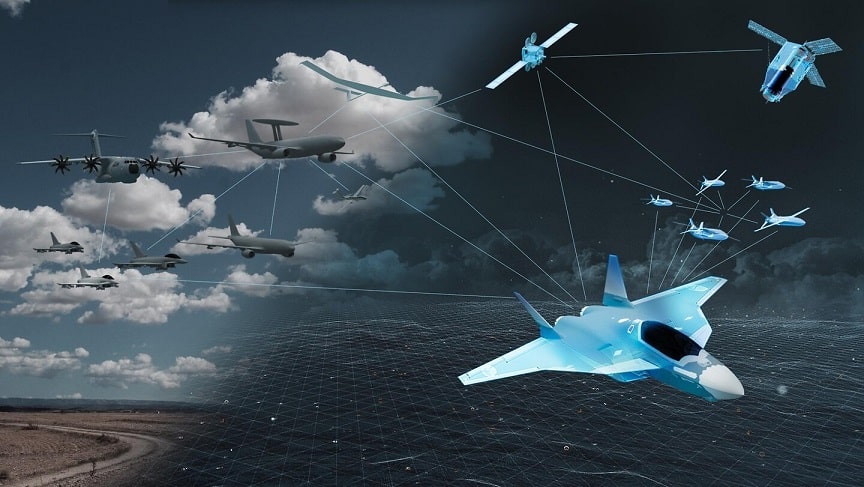Aerospace
Europe’s Future Combat Air System: on the way to the first flight

On behalf of the governments of France, Germany and Spain, the French General Directorate for Armament (DGA) has awarded to Dassault Aviation, Airbus, Indra, Eumet and their industrial partners the contract for the Demonstrator Phase 1B of the Future Combat Air System (FCAS). This landmark contract, amounting to € 3.2 billion, will cover work on the FCAS demonstrator and its components for about three and a half years.
Dassault Aviation, Airbus, Indra and Eumet welcome this major step forward that reflects the determination of France, Germany and Spain to develop a powerful, innovative and fully European weapon system to meet the operational needs of the countries’ armed forces.
This contract notification comes on the heels of the signature of the industrial agreements supporting the demonstrator Phase 1B by Airbus, Dassault Aviation, Indra and Eumet as prime contractors of the programme and by their industrial partners from the three nations. Discussions held over the last months have enabled the creation of a solid basis for cooperation between industry and the three governments.
The successful Phase 1A demonstrators’ associated research and development (R&T) efforts and development activities allowed for the recognition of important technologies and the beginning of the demonstrators’ developments. This demonstration phase 1B will open the door for the program’s development phase by allowing the continued development and maturation of the necessary cutting-edge technologies as well as the consolidation of project architectures. In-flight demonstrations are planned for the program’s subsequent phases by 2028–2029.
The industrial governance of the Phase 1B is organized per domain as follows:
- NGWS Consistency, Demonstrations and Consolidation with Airbus, Dassault Aviation and Indra Sistemas as co-contracting partners
- New Generation Fighter (NGF), with Dassault Aviation for France as prime contractor, and Airbus as main partner for Germany and Spain
- NGF Engine with the 50/50 Joint Venture Eumet -between Safran Aircraft Engines for France and MTU Aero Engines for Germany- as prime contractor and ITP Aero for Spain as main partner
- Unmanned systems, Remote Carrier (RC) with Airbus for Germany as prime contractor, MBDA for France and Satnus for Spain as main partners
- Combat Cloud (CC) with Airbus for Germany as prime contractor, Thales for France and Indra Sistemas for Spain as main partners
- Simulation with Airbus, Dassault Aviation and Indra Sistemas as co-contracting partners
- Sensors with Indra Sistemas as prime for Spain, and Thales for France and FCMS for Germany as main partners
- Enhanced Low Observability (stealth) with Airbus as prime contractor for Spain, Dassault Aviation for France and Airbus for Germany as main partners
- Common Working Environment with Airbus, Dassault Aviation, Indra Sistemas and Eumet as co-contracting partners

Aerospace
Boeing Transfers Rocket Stage to NASA, Paving Way for Human Moon Mission

Boeing has achieved a significant milestone by providing NASA with the second core stage of the Space Launch System (SLS) rocket.
This crucial component, crafted at NASA’s Michoud Assembly Facility (MAF), is set to propel the Artemis II crew into lunar orbit, marking humanity’s return to deep space after a 50-year hiatus.
The monumental Boeing-built rocket stage, the largest element of the Artemis II mission, will embark on a journey aboard the Pegasus barge, traveling 900 miles to NASA’s Kennedy Space Center.
Comparison of two legendary aircraft B777x vs B747 aircraft:Click here
Upon arrival, it will be meticulously integrated with other essential Artemis II components, including the upper stage, solid rocket boosters, and NASA’s Orion spacecraft within the iconic Vehicle Assembly Building. This intricate integration process is a vital step toward the eagerly anticipated Artemis II launch, slated for 2025.
“Boeing-built products helped land humankind on the moon in 1969, and we’re proud to continue that legacy through the Artemis generation,” remarked Dave Dutcher, vice president and program manager for Boeing’s SLS program. “Together, with NASA and our industry partners and suppliers, we are building the world’s most capable rocket and paving the way to deep space through America’s rocket factory in New Orleans.”
NASA, Lockheed Martin Reveal X-59 Quiet Supersonic Aircraft:Click here
The delivery of Core Stage 2 marks a significant achievement in the evolution of the SLS rocket. Towering over 200 feet and powered by four RS-25 engines, this core stage, coupled with two solid-fueled booster rockets, will generate a staggering 8.8 million pounds of thrust. This immense power is crucial to launching Artemis II and future missions into the vast expanse of space.
The SLS rocket stands unparalleled in its capability to transport both crew and substantial cargo to the moon and beyond in a single launch. Its extraordinary capacity will facilitate the delivery of human-rated spacecraft, habitats, and scientific missions to destinations including the moon and Mars, ushering in a new era of space exploration.
-

 Travel1 week ago
Travel1 week agoAir India to Expand US Operations with Three New Routes After a Decade
-

 Travel2 weeks ago
Travel2 weeks agoWhy We Should Avoid These Stamps in a Passport
-

 Airlines1 month ago
Airlines1 month agoInvestigations Reveal Fake Chinese Titanium in Boeing and Airbus Jets
-

 Tech4 weeks ago
Tech4 weeks agoChina’s CATL Plans 1,800-Mile Electric Plane Launch by 2027
-

 Airport3 days ago
Airport3 days agoTop 10 Largest Airports in the World by Size
-

 Aerospace4 weeks ago
Aerospace4 weeks agoChina’s Fighter Jets Turn Wings into Autonomous Drones
-

 Airlines4 days ago
Airlines4 days agoAir India Rolls Out A350s for Delhi-New York JFK and Newark Routes
-

 Defence3 weeks ago
Defence3 weeks agoBoeing Enhances Chinook with New Engines and Block II Upgrades at $96 Million







